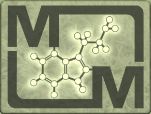 |
MAGISKA MOLEKYLERS WIKI |
Fiskar
Namn: Fiskar
Inneh├źller: Hallucinogena ├żmnen
Inneh├źll
Generell information
Att bli f├Črgiftad av en hallucinogen fisk har ett eget namn, ichthyoallyeinotoxism. Det skall inte f├Črv├żxlas med ichthyosarcotoxism d├żr det handlar om farligare fiskgifter.
Det finns ett antal rapporter om olika arter som ger mardr├Čmmar eller hallucinogena tillst├źnd efter att de ├żtits.
Bland vissa arter kan vissa exemplar ge effekt och andra inte. Det finns ├żven rapporter om att fiskarna bara ├żr aktiva under vissa m├źnader. [1]. Det spekuleras kring att anledningen kan vara att fiskarna ├żter n├źgon havsv├żxt som inneh├źller aktiva ├żmnen[2].
Det finns ├żven uppgifter om att delfiner berusar sig p├ź bl├źsfisk[3], en fiskart som ├żr kraftigt giftig f├Čr m├żnniskor och resulterar i ett antal d├Čdsfall varje ├źr i Japan d├żr den ├żnd├ź ├żts som matr├żtt (Fugu)[4].
Misst├żnka aktiva arter
| Namn | Omr├źde |
|---|---|
| Abudefduf septemfasciatus (Sergeant major) | Stilla havet, Afrika |
| Acanthurus gahhm | V├żstra delarna av Indiska oceanen |
| Epinephelus corallicola (Grouper) | Stilla havet |
| Kyphosus cinerascens (Bluefish) | Syd├Čstra Asien, Stilla havet |
| Kyphosus bigibbus (=Kyphosus fuscus) | Indiska oceanen, Syd├Čstra Asien, Stilla havet |
| Kyphosus vaigiensis (Brass bream) | Indonesien |
| Mugil cephalus (Flathead mullet) | Tropikerna |
| Mulloidichtys samoensis (Golden goatfish) | Indonesien |
| Neomyxus chaptali (Mullet) | Indonesien |
| Sarpa salpa (Salpa) | Spridd ├Čver stor del av v├żrlden. P├źtr├żffad i Danmark. Psykoaktiv i medelhavet. |
| Saganus oramin (Rabbitfish) | Indonesien, V├żstra Afrika |
| Upeneus arge (Goatfish) | Indonesien |
K├żlla: [5]
Acanthurus gahhm
Acanthurus gahhm ├żven kallas "black surgeon" intas av Hamilton Morris[6] varvid han upplevde starka dr├Čmmar. Lokala fiskare p├ź Madagaskar vittnar f├Čr Morris om att deras familj ├żter fisken som ett berusningsmedel. Fiskens huvud och hj├żrna p├źst├źs vara aktiv.
Sarpa salpa
Sarpa salpa ├żr en kustlevande stimfisk som fr├żmst lever av alger och k├żrlv├żxter. ├ģterfinns fr├żmst i Medelhavet och l├żngs Atlantkusten fr├źn Sydafrika i s├Čder till Biscayabukten i norr. Det finns en enstaka rapport fr├źn 1996 d├żr den ├źterfunnits vid Sveriges v├żstkust.
Alger i sl├żktet Caulerpa p├źst├źs ligga bakom att fisken blir psykoaktiv[7]. Caulerpenyne fr├źn algen har visat sig p├źverka nervsystemet[8]
| ŌĆ£ | A 40-year-old man experienced mild digestive troubles and terrifying visual and auditory hallucinations after eating a specimen of Sarpa salpa in a restaurant. As he had severe behaviour troubles, he was managed in the hospital and recovered 36 h after the meal. He was unable to recall the hallucinatory period. Another man, 90-years-old and previously healthy, had auditory hallucinations 2 h after eating a specimen of Sarpa salpa. The two following nights, he had numerous nightmares and recovered spontaneously after a period of 3 days. ŌĆö de Haro & Pommier[9] |
ŌĆØ |
| ŌĆ£ | One tourist, vacationing on the C├┤te dŌĆÖAzur, recalls that after consuming a roast salema in a restaurant, he was unable to get behind the wheel. More than two hours afterwards, he found himself unusually bothered and distracted by animals and giant insects. In another restaurant, in Saint-Tropez, a fellow salema-eater recalls being convinced he had gone crazy, believing he could "see" people's yells and birds' chatter.
Dr. Luc de Haro, a toxicologist at MarseilleŌĆÖs Anti-Poison Center, has seen several such incidents. "Visual and auditory hallucinations, drowsiness, vision trouble... some people think they see Batman or pink elephants. Every two or three years, you see another case. And surely there are more that go undocumented because the patient has slight amnesia afterwards." |
ŌĆØ |
Kyphosus bigibbus
Tidigare k├żnd som Kyphosus fuscus. Arten har visat sig inneh├źlla 5-MeO-DMT[11] & DMT[12]
| ŌĆ£ | Even a variety of fish produces hallucinations. Roughly (1960) described the dream fish present near Norfolk island. The inhabitants stated consuming this fish would produce nightmares. In order to test this claim, Joe Roberts, National Geographic photographer, consumed some of the fish, broiled. The next morning he reported "It was pure science fiction." He saw a new kind of car, pictures of monuments to mark man's first trip into space. The fish is Kyphosus fuscus, closely related to the silver drummer caught off New South Wales. The author, Roughly, also tried the fish and had weird dreams. ŌĆö Hoffer & Osmond[13] |
ŌĆØ |
Externa l├żnkar
- Ōåæ Dream fish Mycotopia
- Ōåæ Hallucinogenic fish Wikipedia (en)
- Ōåæ Daily mail 2013-12-30: What does a dolphin use to get high? A toxic puffer fish that makes them lapse into a trance-like state
- Ōåæ Wikipedia: Fugu
- Ōåæ Bland annat: Halstead, Courville: Poisonous and Venomous Marine Animals of the World: Vol 2, U.S.Government Printing Office 1967
- Ōåæ Hamilton's Pharmacopeia 2016 S├żsong 1, Episod 5 ŌĆō "Fish N Trips"
- Ōåæ Trois cas d'intoxication ciguat├®rique apr├©s ingestion de Sparidae de M├®diterran├®e (De Haro, 1993)
- Ōåæ Caulerpenyne, a toxin from the seaweed Caulerpa taxifolia, depresses afterhyperpolarization in invertebrate neurons (Mozzachiodi, 2001)
- Ōåæ Hallucinatory Fish Poisoning (Ichthyoallyeinotoxism): Two Case Reports From the Western Mediterranean and Literature Review (de Haro & Pommier, 2006)
- Ōåæ Vice 2018-02-23: This Fish Makes People Trip Balls
- Ōåæ Stafford, 1983
- Ōåæ R├żtsch, 1992
- Ōåæ "The Hallucinogens" - Hoffer & Osmond
Ichthyoallyeinotoxism Wikipedia (en)
Sidan ├żndrades senast 4 mars 2018 klockan 15.33.
Den h├żr sidan har visats 10┬Ā690 g├źnger.











